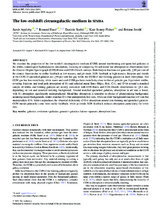The low-redshift circumgalactic medium in SIMBA

View/
Date
2021-08Author
Appleby, Sarah
Dave´, Romeel
Sorini, Daniele
Storey-Fisher, Kate
Smith, Britton
Metadata
Show full item recordAbstract
We examine the properties of the low-redshift circumgalactic medium (CGM) around star-forming and quenched galaxies in
the SIMBA cosmological hydrodynamic simulations, focusing on comparing H I and metal line absorption to observations from
the Cosmic Origins Spectrograph (COS)-Halos and COS-Dwarfs surveys. Halo baryon fractions are generally 50 per cent of
the cosmic fraction due to stellar feedback at low masses, and jet-mode AGN feedback at high masses. Baryons and metals
in the CGM of quenched galaxies are 90 per cent hot gas, while the CGM of star-forming galaxies is more multiphase. Hot
CGM gas has low metallicity, while warm and cool CGM gas have metallicity close to that of galactic gas. Equivalent widths,
covering fractions and total path absorption of H I and selected metal lines (Mg II, Si III, C IV, and O VI) around a matched
sample of SIMBA star-forming galaxies are mostly consistent with COS-Halos and COS-Dwarfs observations to 0.4 dex,
depending on ion and assumed ionizing background. Around matched quenched galaxies, absorption in all ions is lower,
with H I absorption significantly underpredicted. Metal-line absorption is sensitive to choice of photoionizing background;
assuming recent backgrounds, SIMBA matches O VI but underpredicts low ions, while an older background matches low ions but
underpredicts O VI. SIMBA reproduces the observed dichotomy of O VI absorption around star-forming and quenched galaxies.
CGM metals primarily come from stellar feedback, while jet-mode AGN feedback reduces absorption particularly for lower
ions.
